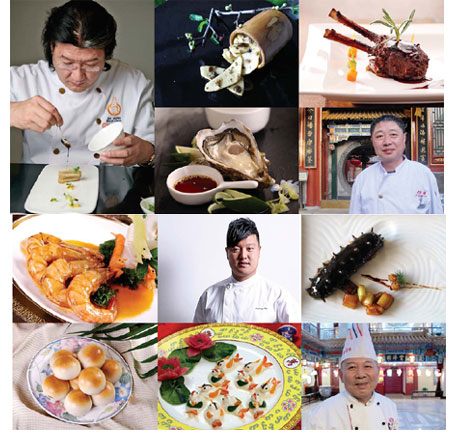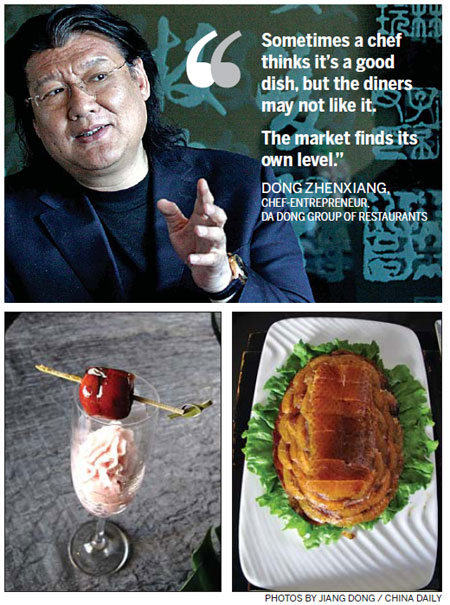These last Chinese chefs
Updated: 2012-02-27 09:40
By Ye Jun (China Daily)
|
|||||||||||


They cooked for kings and scholars. Lauded in prose and poetry, they created an epicurean culture exalted as one of the greatest in the world. Now China's guardians of cuisine are having to move with the times, like everyone else in a country catching up with the rest of the world at warp speed. Ye Jun finds out how they are coping.
Ten years ago, Dong Keping would have eaten a platter of braised and fried intestines without hesitation. The "nine-twist" pork chitterlings are a famous Shandong specialty that is deliciously rich, aromatic and crisp. But Dong, a Beijing gourmet and editor of a popular food program on radio, now thinks twice before ordering, his eye firmly on his medical reports. Many Chinese dishes that were once popular are declining or disappearing, as a rapidly evolving society changes its eating habits, in response to changing times.
New regional influences and creative fusion marrying diverse ingredients and cooking methods have also injected new life into the country's culinary traditions.
Sometimes, it is fading memory that sounds the death knell. In the varied options available to the modern diner, the old-time favorites are all but forgotten. Take furong jipian, a silky but firm custard of finely minced chicken breast and egg that is so well made that you cannot tell there is meat in it. It is a classic example of the elaborate artifice used in imperial cuisine - chicken and egg masquerading as tofu.
"Very few people order the dish now," says executive chef Yin Zhenjiang at Fengze Yuan, a Shandong restaurant established in Beijing in 1930. His venerable establishment is recognized as the most representative of the Shandong school of cooking, credited with influencing the Imperial cuisine of the capital.
Chinese gourmets are increasingly aware of health issues and more and more are opting for healthy, green and environmentally friendly food. Chefs have to learn how to cook with less oil, less salt and no monosodium glutamate.
Restaurants now rarely serve game, at least openly, and traditional banquet specialties such as sharks fin and abalone are being replaced by more acceptable, less endangered options. Organic vegetables, sustainable seafood and free-range poultry are widely available, widely used and widely advertised.
In these last 30 years, Chinese eating habits have undergone many changes.
Before the economic reforms that started in the early 80s, people were more concerned with simply filling their stomachs. At most, there were feasts on occasions such as the Spring Festival.
"In the early years of economic reforms, many types of food were rationed," recalls Li Shuangjin, executive chef with Fang Shan in Beijing, a restaurant started in 1925 by former chefs from the imperial kitchens.
"When more foreigners started to visit China, they boosted the development of Chinese restaurants," he says.
"Beijing chefs also went abroad and to other parts of China. By the 1990s, the restaurant industry had grown to a noticeable scale."
The late 80s and early 90s also saw the rise of regional cuisines in the capital. Cantonese and Sichuan chefs made their presence felt and Cantonese restaurants such as Mingzhu Seafood Restaurant and Hong Kong Gourmet City became phenomenally popular.
Apart from the different palate of flavors, people were stunned by the cost of an average meal there - which could be several hundred to more than a thousand yuan. It was the equivalent of an average month's salary for many.
"The Cantonese restaurants represented the high-end dining market, while the Sichuan eateries catered to the populace," says Dong Keping, who produces the food program at 87.6 FM Beijing.
After the initial shock, many Chinese chefs from all branches of regional cooking adopted "foreign" ingredients, seasoning and even Western presentation with great enthusiasm and innovation.
Wagyu beef and cod, never heard of before, are now standard on many Chinese menus, including those of the four cornerstone cuisines of Chinese cooking - Shandong, Cantonese, Sichuan and Huaiyang.
Intra-provincial diasporas also changed eating habits. Migrant workers and business professionals from all parts of China brought their regional favorites to Beijing and the other Chinese mega-cities where their skills and expertise were in demand.
This can be considered the Second Wave.
It was in the Qing Dynasty (1644-1911) that the four major cuisines of China were first defined, corresponding to the four busiest business hubs of that time. With better communication and transportation, the four gradually became eight - with the addition of Hunan, Fujian, Zhejiang and Anhui regional styles.
According to Dong, another four major influences were sometimes included, notably the food from Beijing and Shanghai, as well as Chinese Muslim and vegetarian cuisines.
"Exotic ingredients from outside of Beijing, and ethnic snacks from little remote places grow popular," says Dong. "Nowadays, wild mushrooms picked at 3 am in Yunnan can arrive in Beijing the same morning."
As the enthusiasm for Cantonese cuisine wanes, there is a queue of options waiting to take its place. Xinjiang restaurants, Yunnan eateries and Hunan private dining rooms are cropping up like spring grass.
The private dining rooms, especially, appeal to jaded appetites tired of daintily presented dishes on ornate plates. They offer dishes that are unique, inexpensive, and tasting of home.
Yin Zhenjiang believes Chinese dishes will no doubt evolve as time passes, with a salad bowl of regional cuisines catering to a new generation of diners and dining habits.
The traditional cuisines guarded by the master chefs will need to change as well.
"If you improve the traditional dishes and get them accepted again, that in itself will be innovation," Yin says. He thinks the move away from a planned economy has opened the way for an active and interactive culinary industry.
But the market economy also claims its victims. Take the state-run Fengze Yuan, for example. It currently faces a talent crisis because one chef who has worked here for five years gets just 2,000 yuan ($317) a month. If he moves to a private restaurant, he can easily get paid double.
For the older restaurants, change is inevitable and keeping up with the market may be the only way to survive.
The best business model now seems to point to one particular chef and his iconic restaurant - iconic only after slightly less than 10 years, hardly a blip on the timeline of Chinese cuisine.
Da Dong Peking Roast Duck Restaurant, named after its charismatic chef-entrepreneur Dong Zhenxiang, serves up Peking duck and foie gras, sometimes on the same platter. A typical menu offering can be either Boston lobster served with Beijing zhajiang noodles or a cigar of Yangzhou-style rice-wine marinated crab roe and meat with chilled foie gras.
In the last decade, Da Dong has changed its menu every year. Chef Dong says his insistence on refreshing the choices offered to his customers is simple. He intends to keep them coming.
Dong is a market leader today, and his creations are praised by critics and copied by competitors. To many, he is the chef leading Chinese cuisine out of the doldrums and into an age of renaissance, but he tells us he has no such lofty ambitions, merely a desire to claim his fair share of the market.
"The only criteria is customer preference," he says. "Sometimes a chef thinks it is a good dish, but the diners may not like it. The market finds its own level."
Dong says the food at his restaurant, which he calls "artistic conception cuisine", is his response to heightened taste and palate awareness among his patrons, as well as a better appreciation of culinary lifestyle.
Dong caters to them by applying aesthetics like Chinese painting, miniature landscaping, poems and prose to his food, creating an experience that starts with the calligraphy on the menu to the delicate carvings on the plate.
He also believes in following the seasons, a concept extracted from his classical training in Shandong cuisine. So he travels to Tianmu Mountain in Zhejiang for its famous bamboo shoots and serves them fried with preserved winter vegetables in a section of bamboo, garnished with a sprig of plum blossoms.
"The direction is to learn from and follow Nature," says Dong. "What Nature has to offer is the best."
To him, fusion cooking is a natural response to changing times and China's cuisine will continue to fuse and merge just as its people will continue to migrate and assimilate.
When we ask Dong to look into the crystal ball, he says: "It will be a fusion of the different branches of Chinese cuisine. It will also incorporate healthy cooking and techniques and ingredients gathered from all over China, and the world."
Dong Keping agrees. "If Chinese food is to walk onto the world stage," he says, "it will have to be a form that is acceptable to both foreigners and to the Chinese."
Today's Top News
Rescuers race against time for quake victims
Telecom workers restore links
Coal mine blast kills 18 in Jilin
Intl scholarship puts China on the map
More bird flu patients discharged
Gold loses sheen, but still a safe bet
US 'turns blind eye to human rights'
Telecom workers restore links
Hot Topics
Lunar probe , China growth forecasts, Emission rules get tougher, China seen through 'colored lens', International board,
Editor's Picks

|

|

|

|

|

|





